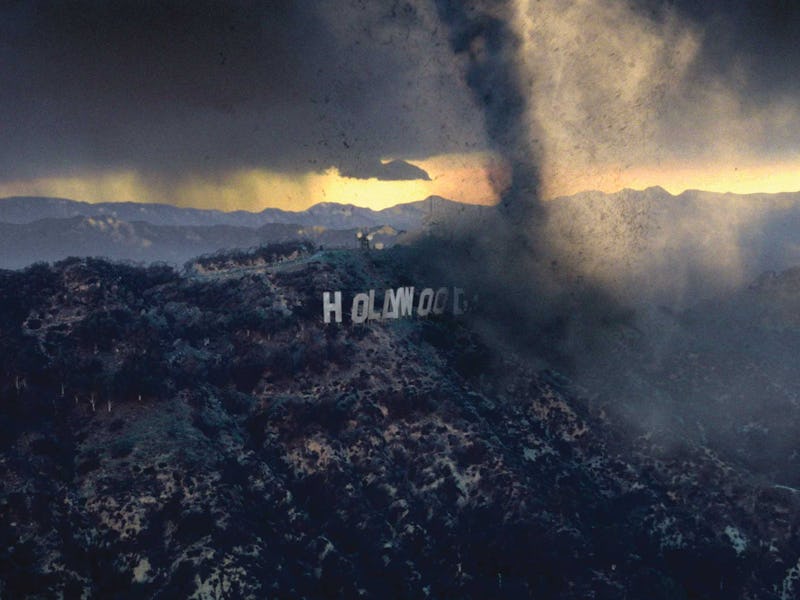Roland Emmerich's most ridiculous movie isn't quite as funny as it used to be
“For years, we operated under the belief that we could continue consuming our planet's natural resources, without consequence. We were wrong.”

When Hurricane Ida’s flash floods wreaked havoc in New York, New Jersey, and Pennsylvania last year, social media went haywire with photos and videos of torrential rainfall, trains drowning in their subterranean platforms, and garbage floating down highways.
But social media also proliferated fake news. Specifically, an image depicting partially submerged New York taxis as people desperately flee was shared on Twitter and Instagram. This was, in fact, a still from Roland Emmerich’s 2004 smash storm thriller The Day After Tomorrow. Dramatized as it may be, it was able to dupe hundreds into believing movie magic was a genuine weather report.
If there’s anything Roland Emmerich loves, it’s a sci-fi disaster flick with a summer blockbuster budget. He’s known best for Independence Day (1996), the film that transformed Will Smith from Fresh Prince to bonafide superstar, and he’s also gifted us Godzilla (1998), 2012 (2009), and most recently, Moonfall (2022).
Perhaps none of Emmerich’s other calamity films come as close to reality as The Day After Tomorrow, a hyperbolic depiction of global catastrophe wrought by the climate crisis. The movie’s 416 special effects visual shots (created by nine different effects houses and over 1,000 artists) include twisters, quakes, and downpours of Biblical proportions.
The Day After Tomorrow is both an absolute blast to watch and also terrifying, teetering between popcorn fare and prophecy. Its science may be flimsy, but it’s still an effective conversation starter about global warming. It’s also leaving HBO Max at the end of the month. Here’s why you need to watch it now.
18 years later, some of The Day After Tomorrow’s wildest freeze-frames aren’t too far removed from what’s on the news.
The Day After Tomorrow follows Jack Hall (Dennis Quaid), an American paleoclimatologist for the National Oceanic and Atmospheric Administration. At a UN conference in New Delhi, he warns attendees that the climate is shifting radically. On his latest research mission in the Larsen Ice Shelf, he says, the shelf suddenly split away while drilling for core samples. But American Vice President Raymond Becker (Kenneth Welsh doing his best to channel Dick Cheney) poo-poos Hall’s anxieties over the fate of Earth.
Hall’s distress turns out to be warranted. He and fellow oceanographer Professor Terry Rapson (Ian Holm) discover a drastic ocean temperature drop in the Atlantic. Hall begs the Vice President to start planning for apocalyptic storms, but Becker continues to not take Hall seriously.
Sleet soon hits the fan. Massive tropical depressions, gigantic hurricanes and hail storms, tornado outbreaks, and massive tsunamis raze the world’s metropolises, in advance of what Hall believes to be the atmosphere’s way of preparing for the next Ice Age. While Hall still doesn’t have the ear of the government, he does have his son Sam (Jake Gyllenhaal), Sam’s friends Brian Parks (Arjay Smith) and Laura Chapman (Emmy Rossum), and his wife, Dr. Lucy Hall (Sela Ward). Together, they attempt to do damage control for the apocalypse. But not everyone is willing to accept that they’re seeing the end of their world as they know it — or that it’s humanity’s fault for fast-tracking climate catastrophe.
Jake Gyllenhaal, Emmy Rossum, and Arjay Smith in The Day After Tomorrow.
The Day After Tomorrow is bolstered by its stacked cast, who give their performances so much that it really does feel like mega-tornadoes are ripping right through Manhattan before their eyes. But it’s the flick’s impressive optics and creative scenarios depicting the worst possible aftermath of climate change that make it memorable.
Back in 2004, critics and audiences weren’t too keen on these apocalyptic visions of extreme weather. Roger Ebert described the film as “profoundly silly,” and reviews for The Day After Tomorrow could generously be described as mixed.
Meanwhile, numerous weather scientists were asked how much of the film was in the realm of possibility. The answer? Not much. NASA research meteorologist Marshall Shepherd summed up the scientific response: “I’m heartened that there’s a movie addressing real climate issues. But as for the science of the movie, I’d give it a D minus or an F.”
Dennis Quaid as Jack Hall and Dash Mihok as Jason Evans in The Day After Tomorrow.
But The Day After Tomorrow came out before Hurricane Katrina. It came out before the Bomb Cyclone in the Mississippi valleys, Hurricane Michael in the Florida Panhandle, Hurricane Harvey in Houston, Superstorm Sandy across the Northeast, Hurricane Maria in Puerto Rico, and the wildfires that ravaged California in the late 2010s for nearly four years. Super-tornados may never destroy Manhattan (we hope), but some of its over-the-top natural disasters don’t seem so ludicrous now.
The Day After Tomorrow leaves HBO Max on November 30.